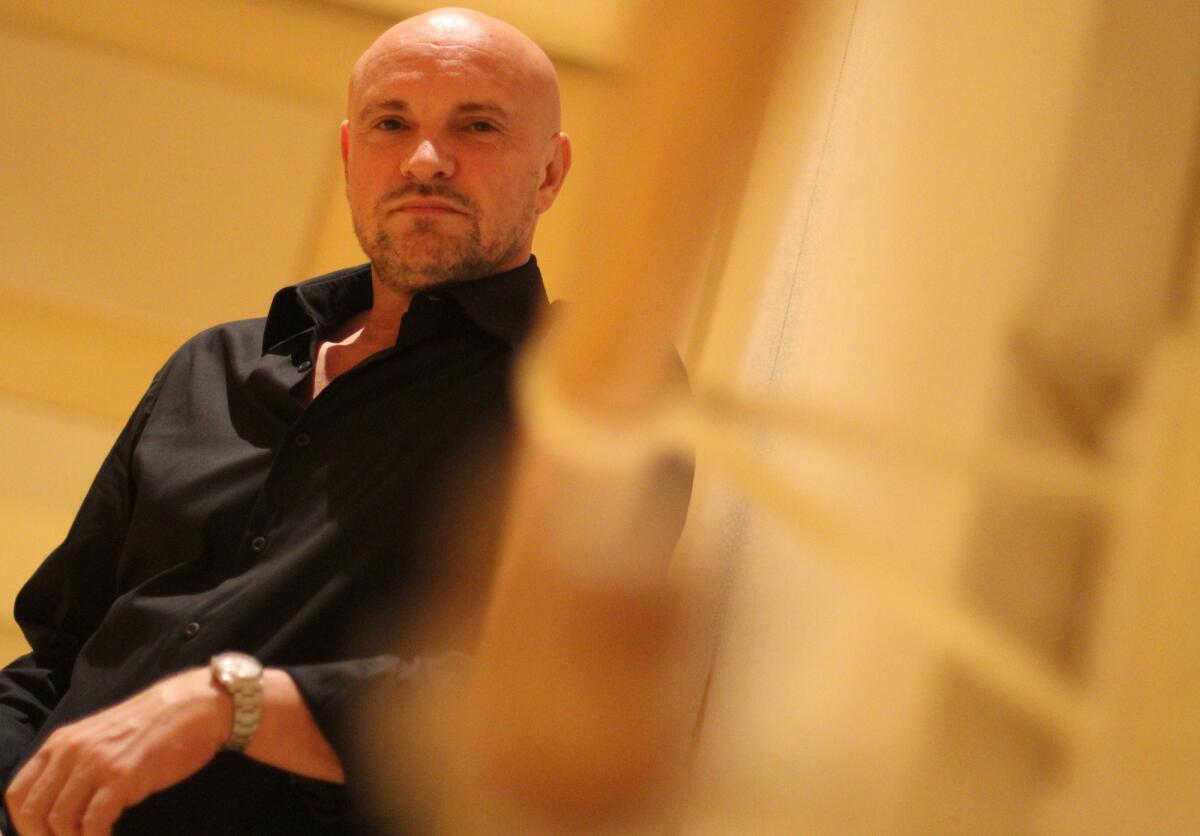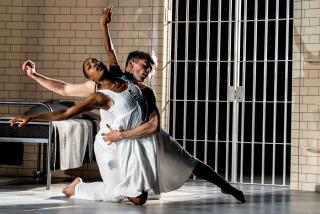A fairy-tale life for ‘Lac’ choreographer Jean-Christophe Maillot

Think “story ballet,” and the tutu and tiara-clad princesses that come to mind are usually onstage — not behind the scenes. But French-born choreographer Jean-Christophe Maillot found a real-life noblewoman in Caroline, the Princess of Hanover, who tapped Maillot to be artistic director of Les Ballets de Monte-Carlo in 1993.
This first-born daughter of the late Princess Grace of Monaco, former American movie star Grace Kelly, founded the troupe in 1985 per her mother’s wishes: to carry on a balletic tradition that began in 1909, when the principality was home to impresario Sergei Diaghilev’s Ballets Russes.
The match has proved ideal for Maillot, a youthful 53 with a shaved head, sparse Van Dyke beard and constant cigarette in hand, who has created some 30 works for the troupe. Maillot spoke of his good fortune last fall in Costa Mesa, where he was fine-tuning a ballet he created for superstar Diana Vishneva and where his company of 50 dancers returns to Segerstrom Hall next weekend with four performances of the U.S. premiere of “Lac.”
PHOTOS: Arts and culture in pictures by The Times
Maillot’s take on the ballet about birds, women, life, love, an angst-ridden prince and death premiered in Monaco in 2011, the year before the troupe first visited Orange County with its “Cinderella.”
But the question remains: Does the world really need another “Swan Lake?”
Maillot, an unabashed romantic who admits he hasn’t made a ballet without a kiss for 30 years, said his “Lac” is a modern update that deals in opposites and attractions, childhood fears and nightmares, and the perfect idea of love, with death ultimately trumping all.
“The black swan is this part of the woman that has to do with sexuality, strength and power,” Maillot said. “The white swan is the metaphysical way of seeing a woman, the woman we loved when we were 7 years old. In my pieces I’m always speaking about relations between men and women — how we connect.”
His starting point, Maillot added, was to make the audience understand “what makes a woman a swan during the day, a woman by night — but that she is still the same.”
PHOTOS: The most fascinating arts stories of 2013
One solution was to take away the hands, replacing them with feathers, courtesy of Philippe Guillotel’s haute couture-like costumes. “When night comes, feathers fall,” Maillot said, “and she can have a relationship — the fleshy part and the spiritual part. Does this exist? And if it doesn’t, why can that not exist in a ballet for one night?”
To help tell the tale of Odette, a woman turned into a swan by an evil sorcerer, the Frenchman enlisted Jean Rouaud as librettist (a first for a winner of the Prix Goncourt, one of France’s most important literary prizes). Together, they set the story against a Machiavellian family backdrop, making the nefarious wizard Rothbart a woman. Maillot’s wife, Bernice Coppieters, a longtime company member, dances the role, sporting jet-black feathery garb that wouldn’t be out of place in Cher’s closet.
“Light and darkness, good and evil, mankind and animality,” Rouaud wrote in an email, “the ballet places two love triangles on top of each other. The first is the King, Queen and Rothbart, the second, Prince Siegfried and the two swans. In the end, it’s a disaster for the children who are crushed by parents unable to step down. This brings us to today’s youth, always expecting to be given priority.”
CRITICS’ PICKS: What to watch, where to go, what to eat
Not necessarily for Maillot, whose fierce dedication and raw talent helped pave his way. Growing up in Tours, in central France, he rose through the ranks, training in Cannes with American ballerina Rosella Hightower, winning the Swiss Prix de Lausanne international dance competition in 1977 and then joining John Neumeier’s Hamburg Ballett, before an injury ended his performing career. In 1983, Maillot was appointed choreographer and director for the Ballet du Grand Théâtre de Tours, making 20 works for his hometown troupe, which later became a national choreographic center.
“Creating a company gives me tools with which I can work,” Maillot said, “but being a choreographer is not being a painter or writer. You don’t have direct transmission of your work. It depends on others, and it’s a different way of creating.”
Jerusalem Post dance critic Ora Brafman, who has been covering Les Ballets de Monte-Carlo for years, cites “Lac” as one of Maillot’s best works: “Intense and tempestuous, ‘Lac’ is a highly dramatic, rather sinister affair with layers of new psychological insights, challenging the original libretto.”
PHOTOS: Hollywood stars on stage
Those insights, Maillot said, are references to the Black Swan being the illegitimate child of Siegfried’s father (the King) and Siegfried as homosexual. But whatever audiences read into the scenario, with the backdrop of Ernest Pignon-Ernest’s sleek, neo-modernist sets and Tchaikovsky’s indelible score (heard on tape, somewhat truncated), the choreography is top-notch. It’s razor-sharp and intricate, with quivering bourrées accentuated by backward corps stomping, gossamer arms and spectacular lifts, all articulated by stunning performers.
Dancers say they adore Maillot, who also programs works by the world’s foremost choreographers, including William Forsythe, Sidi Larbi Cherkaoui and Shen Wei. The typical dancer’s stay is seven or eight years.
“What impresses me is his way of keeping them all together and linking them up in order to serve a purpose,” said Gaëtan Morlotti, 46, who met Maillot in 1987 and was with Ballets de Monte-Carlo from 1993 until last month.
PHOTOS: Celebrities by The Times
Maillot has endless ideas, Morlotti said by email. “Jean-Christophe also has the capacity to merge different worlds, and the company has a strong soul that becomes a marvelous tool serving creation.”
In 2000, Maillot founded the Monaco Dance Forum, an international showcase, and in 2011, he became head of a new organization uniting his troupe, the Dance Forum and the Princess Grace Academy, one of Europe’s top training schools, under a single organization. Still, Maillot remains humble.
“Every day, I have fantastic people around,” he said. “And I had great luck to meet the princess — that’s a fairy tale, but a real one. She gave me the time, the trust and freedom to work. I am one of those princes in the fairy tales, and every morning I wonder why it happened to me. The only way for me to do this is to keep giving back.”
More to Read
The biggest entertainment stories
Get our big stories about Hollywood, film, television, music, arts, culture and more right in your inbox as soon as they publish.
You may occasionally receive promotional content from the Los Angeles Times.






